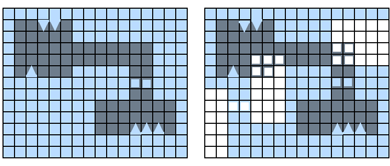Download
Macintosh
EDIT: Sorry if you got a version where the Ratbots were messed up. They should be fixed now in the new version, just re-download it!
Gameplay Trailer
A Doozie
 Doozie would be putting it lightly. This one took a lot of work, and it’s far from perfect, but I’m proud of it and I’m sharing it with you! This week’s game is called ZTR: Zap That Robot! and it’s a game about zapping robots while running around a randomly-generated arena. There are two enemies in the game, Ratbots and the Core. The Core is the most vital part of the game. It wanders around the level and is non-aggressive, however it will hurt you if touched. “Zapping” the Core steals its energy, sapping it of electrical power and charging your own power. Once your energy reserves are full, the Core deactivates, unlocking the door to the next level. Ratbots wander around and eventually find you, make a beeline towards you, and begin to zap you with electricity. You can zap the Ratbots for a few seconds to destroy them, but be careful: this uses up some of your energy reserves. The idea is to see how many levels you can get through without dying, while each level gets increasingly more difficult.
Doozie would be putting it lightly. This one took a lot of work, and it’s far from perfect, but I’m proud of it and I’m sharing it with you! This week’s game is called ZTR: Zap That Robot! and it’s a game about zapping robots while running around a randomly-generated arena. There are two enemies in the game, Ratbots and the Core. The Core is the most vital part of the game. It wanders around the level and is non-aggressive, however it will hurt you if touched. “Zapping” the Core steals its energy, sapping it of electrical power and charging your own power. Once your energy reserves are full, the Core deactivates, unlocking the door to the next level. Ratbots wander around and eventually find you, make a beeline towards you, and begin to zap you with electricity. You can zap the Ratbots for a few seconds to destroy them, but be careful: this uses up some of your energy reserves. The idea is to see how many levels you can get through without dying, while each level gets increasingly more difficult.
The Good, the Bad, etc.
 I have to admit, the level generation is pretty cool. It’s not always perfect, but it creates a wide variety of maps from a very limited selection of pieces. I’ve spent probably too much time simply generating new maps and running around in them, which is very fun, but running isn’t all you’ll be doing in ZTR. The gameplay is, as far as I know, fairly unique/experimental, and for what it is I think it came out pretty well. I wish I had more time for playtesting, but I’ve played enough of my own game to tell you that it’s pretty fun. I am aware that it gets grindy and tedious after a few levels, so maybe if I decide to flesh this game out in the future, I can alter the gameplay. And now on to the bad: it’s kind of buggy. For being built in a week it works surprisingly well, but the Ratbots get stuck inside geometry, the Core wanders into corners and gets himself trapped, sometimes parts of levels might generate a bit funky… however problems like these are to be expected when dealing with a procedurally generated world; Things are often highly unpredictable and you can only try your best to minimize the chaos. That said, check out the game (it’s free!) and come back soon! I’ll post a “development update” later in the week when I’m a bit less sleep deprived. Thanks!
I have to admit, the level generation is pretty cool. It’s not always perfect, but it creates a wide variety of maps from a very limited selection of pieces. I’ve spent probably too much time simply generating new maps and running around in them, which is very fun, but running isn’t all you’ll be doing in ZTR. The gameplay is, as far as I know, fairly unique/experimental, and for what it is I think it came out pretty well. I wish I had more time for playtesting, but I’ve played enough of my own game to tell you that it’s pretty fun. I am aware that it gets grindy and tedious after a few levels, so maybe if I decide to flesh this game out in the future, I can alter the gameplay. And now on to the bad: it’s kind of buggy. For being built in a week it works surprisingly well, but the Ratbots get stuck inside geometry, the Core wanders into corners and gets himself trapped, sometimes parts of levels might generate a bit funky… however problems like these are to be expected when dealing with a procedurally generated world; Things are often highly unpredictable and you can only try your best to minimize the chaos. That said, check out the game (it’s free!) and come back soon! I’ll post a “development update” later in the week when I’m a bit less sleep deprived. Thanks!




